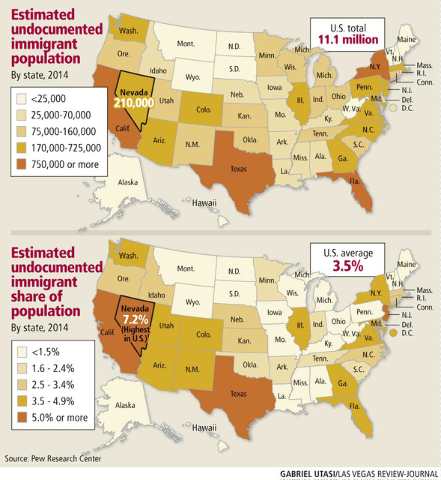Nevada’s undocumented immigrants declined from 2009-2014
Nevada’s undocumented immigrant population dropped from 2009 through 2014, though the proportion of residents without legal status to remain in the U.S. remained highest in the nation, at 7.2 percent of the total state population, the Pew Research Center reported Tuesday.
The decline meant Nevada had approximately 210,000 undocumented residents at the end of 2014, roughly 30,000 fewer than it did in 2009, according to the Pew analysis of the Census Bureau’s American Community Survey data. That made it one of seven states where the number of undocumented residents declined over the period, while six states registered gains.
Nationally, the report found that the population of undocumented immigrants has stabilized since the end of the Great Recession at approximately 11.1 million, with a decline in the number of undocumented Mexicans offset by increasing numbers of unauthorized immigrants from Asia, Central America and sub-Saharan Africa. Mexican immigrants still make up the biggest group of undocumented immigrants in the U.S. – 52 percent of the total, the report said.
The decline of the undocumented immigrant population in Nevada began after 2007 when it reached a high point of 240,000, the Pew report said. The drop was steepest in the immediate aftermath of the recession, hitting 210,000 in 2012 and maintaining that level through 2014, it said.
That did not change Nevada’s standing as the state with the highest proportion of undocumented immigrants, although that figure also dipped from 7.6 percent in 2012 to 7.2 percent of the total population of nearly 2.4 million in 2014, according to Pew data. The latter was still more than 1 percent higher than rates in the second and third highest states, Texas and California, at 6.1 and 6 percent, respectively.
Nevada had the highest percentage of undocumented immigrants in the labor force, working or looking for work – 10 percent in 2012 – followed by Texas and California at 9 percent, according to a separate study last year by Pew.
Tony Payan, director of the Mexico Center at Rice University and author of “The Three U.S.-Mexico Border Wars: Drugs, Immigration and Homeland Security,” said Nevada’s high population of undocumented workers is a result of the service and construction industries, which provide large numbers of low-skilled jobs.
“The 2008, 2009 financial crisis also explains why there has been an exodus” because those industries are vulnerable in an economic downturn, he said. “This hypothesis will be tested, of course, when the economy is in full recovery.”
Emma Sepulveda, director of the Latino Research Center at the University of Nevada, Reno, agreed, but said returning undocumented workers might not stay permanently.
“It’s an illusion that we think that people from many countries come because they want to move to Nevada,” she said. “In spite of what a lot of people think, a lot of Mexican workers leave their family behind and come with the hope of raising enough money to settle in their country of origin.”
Laura Martin, associate director of the Progressive Leadership Alliance of Nevada (PLAN), which advocates for immigrant rights, said President Barack Obama’s tough deportation policy during his first term also was likely a factor. “The numbers leveled off as the Obama administration deported millions of undocumented immigrants,” she said. “The number of unauthorized entries was roughly the same number of people deported every month.”
In addition to Nevada, populations of undocumented residents also dropped in Alabama, California, Georgia, Illinois, Kansas and South Carolina from 2009 through 2014, Pew said.
Six states saw their undocumented populations rise during the period – Louisiana, Massachusetts, New Jersey, Pennsylvania, Virginia, and Washington. With the exception of Louisiana, the increases were driven by an influx of immigrants from countries other than Mexico.
Undocumented immigrants also make up a high percentage of Nevada’s overall foreign-born population 36 percent – but that’s lower than states such as Arkansas, North Carolina and Oklahoma, which have rates of 40 percent or more.
















